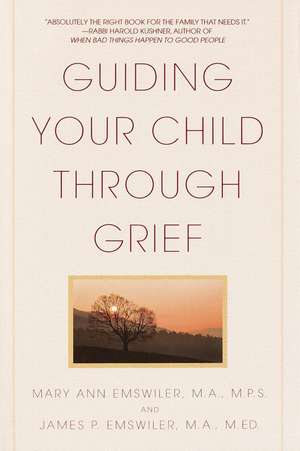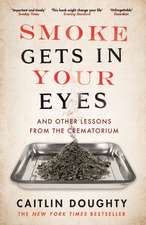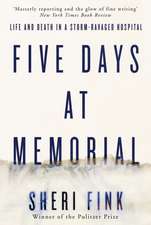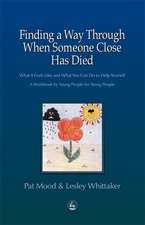Guiding Your Child Through Grief
Autor Mary Ann Emswiler, James P. Emswileren Limba Engleză Paperback – 31 iul 2000
Guiding Your Child Through Grief, by the founders of the New England Center for Loss & Transition and The Cove, a highly praised program for grieving children, takes away the uncertainty and helpless feelings we commonly feel as we reach out to children who mourn. This caring and compassionate guide offers expert advice during difficult days to help a child grieve the death of a parent or sibling. Based on their experience as counselors--and as parents of grieving children--the authors help readers to understand:
The many ways children grieve, often in secret
Changes in family dynamics after death--and straightforward, effective ways to ease the transition
Ways to communicate with children about death and grief
How to cope with the intense sorrow triggered by holidays
The signs grief has turned to depression--and where to find help
And more insights, information, and advice that can
help a child heal
Preț: 179.35 lei
Nou
Puncte Express: 269
Preț estimativ în valută:
34.32€ • 35.56$ • 28.64£
34.32€ • 35.56$ • 28.64£
Carte tipărită la comandă
Livrare economică 17-24 martie
Preluare comenzi: 021 569.72.76
Specificații
ISBN-13: 9780553380255
ISBN-10: 0553380257
Pagini: 300
Dimensiuni: 155 x 229 x 18 mm
Greutate: 0.44 kg
Editura: Bantam
ISBN-10: 0553380257
Pagini: 300
Dimensiuni: 155 x 229 x 18 mm
Greutate: 0.44 kg
Editura: Bantam
Recenzii
Praise For Guiding Your Child Through Grief
"Absolutely the right book for the family that needs it."
--Rabbi Harold Kushner, author of When Bad Things Happen To Good People
"A monumental contribution to the countless children who can be helped to cope with the loss of a loved one instead of left unassisted because the adults around them lack an awareness of their needs."
--Therese Rando, Ph.D., author of How to Go On Living When Someone You Love Dies
"An excellent resource to help you bring forth what is within your child, your self and your family so it does not destroy any of you. The tears of unexpressed grief extinguish life's bright candle. Read on and light the dark tunnel so others may follow.
--Bernie Siegel, M.D., author of Love, Medicine & Miracles and Prescriptions for Living
"With the Emswilers' vast experience, I know of no one who can offer such compassion, comfort, and guidance during the lonely and painful times of a child's grief--An exceptional book."
--Rabbi Earl Grollman, author of Talking About Death: A Dialogue Between Parent and Child
"An excellent resource for parents, whether they are just beginning to help their children and themselves adjust to the anticipated or recent death of a family member, or whether they are looking for insight into supporting further adjustment several years later. Clinicians, counselors, teachers, and other members of the broader community will also benefit from reading this book so that they, too, can learn how to help children and their families deal with a loss."
--David J. Schonfeld, M.D., Associate Professor of Pediatrics and Child Study, Yale University School of Medicine
"I wish Guiding Your Child Through Grief could be in the hands of every parent with a child or adolescent grieving a death. Of special help is their section on the challenges of stepparenting children after the death of a parent."
--Donna L. Schuurman, Ed.D, Executive Director, The Dougy Center for Grieving Children, Portland, Oregon
"Absolutely the right book for the family that needs it."
--Rabbi Harold Kushner, author of When Bad Things Happen To Good People
"A monumental contribution to the countless children who can be helped to cope with the loss of a loved one instead of left unassisted because the adults around them lack an awareness of their needs."
--Therese Rando, Ph.D., author of How to Go On Living When Someone You Love Dies
"An excellent resource to help you bring forth what is within your child, your self and your family so it does not destroy any of you. The tears of unexpressed grief extinguish life's bright candle. Read on and light the dark tunnel so others may follow.
--Bernie Siegel, M.D., author of Love, Medicine & Miracles and Prescriptions for Living
"With the Emswilers' vast experience, I know of no one who can offer such compassion, comfort, and guidance during the lonely and painful times of a child's grief--An exceptional book."
--Rabbi Earl Grollman, author of Talking About Death: A Dialogue Between Parent and Child
"An excellent resource for parents, whether they are just beginning to help their children and themselves adjust to the anticipated or recent death of a family member, or whether they are looking for insight into supporting further adjustment several years later. Clinicians, counselors, teachers, and other members of the broader community will also benefit from reading this book so that they, too, can learn how to help children and their families deal with a loss."
--David J. Schonfeld, M.D., Associate Professor of Pediatrics and Child Study, Yale University School of Medicine
"I wish Guiding Your Child Through Grief could be in the hands of every parent with a child or adolescent grieving a death. Of special help is their section on the challenges of stepparenting children after the death of a parent."
--Donna L. Schuurman, Ed.D, Executive Director, The Dougy Center for Grieving Children, Portland, Oregon
Extras
BOTH OF US WROTE THIS BOOK, BUT IT BEGAN WITH JIM'S STORY.
Here it is in his own words:
June 24, 1989, was a beautiful summer morning with the sweet smell of flowers in the air. Our family had just completed a stressful week as we had gone through the death, wake, and funeral of my father-in-law. This was the first death of a loved one for my children. They adored their grandfather and would miss his bear hugs and tenderness and guidance. As they peered at his lifeless body at the wake and joined in the prayers at the funeral, I could see them struggle with this new concept, death.
Little did they know just how deep and long-lasting that struggle would be.
The day after the funeral, we climbed into the car for the one-hour drive home. My wife, Mary, sat next to me, and our eleven-year-old, Greg, and our eight year-old, Katie, were in the backseat. Patrick, our fourteen-year-old, had gone home with a friend the night before.
As we drove down the highway, I told Mary about a potential job promotion, which would mean more income for us but also more travel and time away from the family for me. I asked her what she thought about the idea, but she didn't respond. I glanced over and saw her head cocked back. I thought she had a bloody nose and asked if she was all right. When she still didn't respond, I knew something was terribly wrong. She just stared at the ceiling, her body stiff, the fingers of her left hand opening and closing as if to communicate in some way. I shouted, "Hold on, Mary!" and floored it. Mary kept breathing in and breathing in until she could hold no more air within her. And then she exhaled deeply--the same ghostly exhale I had seen her father take just a few days before. The kids screamed from the backseat, "What's wrong, Dad? What's wrong?!" Mary slumped onto my shoulder, and a single tear fell slowly down her left cheek.
I pulled off the highway and into a hotel parking lot. Someone called an ambulance while I performed mouth-to-mouth resuscitation, thinking this had to be some kind of absurd nightmare. But there was no pulse and no heartbeat in my wife's limp body. A doctor and nurse came out of the hotel and began CPR on Mary until the ambulance arrived. The paramedics pulled out the defibrillator and revived her silent heart.
But it was too late. That silent heart, now revived, was twice its normal size when it gave out. Mary would be able to live with the help of tubes and machines, but she was brain-dead.
The day after Mary's heart attack, the doctor informed me that there was no hope of recovery for Mary. I gathered myself together as best I could, then went home to get the kids. I brought them to the hospital, and we stood around Mary's bed, the sound of air being pumped into her lungs echoing in our ears. What I did next was the most difficult thing I have ever done in my life. I looked down at our three children, their innocent faces shivering with fear, their arms gripping my legs as tightly as they could. I took a deep breath and somehow the words came out: "Your mom's not going to make it. She's going to die."
The outburst of primal wails that followed seemed to last forever. We just stood there as a wounded family and let the tears flow and gush until there was nothing left inside. Each child then walked over to Mary, kissed her on the cheek, and said, "Good-bye, Mommy. I love you."
Their aunt escorted them out of the room; I remained behind as the nurse disconnected the life-support system. I looked down at Mary, and I looked deep within myself; both looks were stares of disbelief. My thirty-nine-year-old wife of eighteen years and the mother of our three wonderful kids was dead.
I walked out of the room and down the hospital hallway. I had never felt so alone. I remember that moment as if it were yesterday. I will never forget it, never.
Mary had no apparent medical problems, nor had she complained of any difficulties. Her health had seemed as perfect as our life. We both had good jobs, a home in the suburbs, three children, two cars, and a strong 401(k). In sixty seconds on June 24, 1989, however, my life and the lives of my children changed forever. In a matter of moments, I went from being a husband to a widower, from sharing the responsibilities of raising children to being a single parent. Before, I had been a sales manager, traveling up and down the East Coast; afterward, I left that position to take care of my three young ones. In a matter of moments, my world turned upside down.
As deep as my pain was at losing Mary, it spiraled even lower whenever I thought about my children. They were so young and would have to grow up without a mom. No mother would hold them or tuck them in at night, no mom would cook for them or shop for clothes that matched. My thoughts jumped ahead to the junior prom, graduation from high school, choosing a college, getting married, and having
babies--all without their mother to help them and guide them. This was not what I had planned.
But I have discovered since then that life is no more a trip to be planned than grief is a problem to be solved. Both are journeys to be traveled. And what a journey it has been.
A few years after Mary died, I remarried. A mutual friend had introduced me to Mary Ann, and we all went to the theater one evening. After the play, I offered to drive Mary Ann home. "But first," I told her, whipping out coupons from my shirt pocket, "I need to stop at the grocery store to pick up a few things for the kids' breakfast." How rusty I was at the dating game--what an outstanding romantic overture! Fortunately, Mary Ann thought it was amusing to grocery-shop at eleven-thirty P.M. No doubt she realized that I was a man who could introduce her to new experiences in life!
And she was right. When we married in 1991, Mary Ann, a business executive, entered a family with two teenage boys and one preteen girl who had experienced the sudden, untimely death of their mother.
As Jim walked down the hospital corridor after Mary died, the first thought that entered his mind was: "Will my kids be okay?" The looks on his three children's faces as they learned about their mother's death were nothing short of traumatic. Would this experience--so sudden and so unnatural--ruin their lives forever?
For both of us, the question of how to help children through grief became a driving passion. Soon after we married, we both left our jobs in the corporate world to found the New England Center for Loss and Transition, a nonprofit organization dedicated to helping those who grieve the loss of a loved one, particularly children.
After Mary died, Jim had discovered that many mental health professionals knew little about issues of grief and loss. When he talked to one therapist about his feelings, she said, "I'd like to help you more, but I really don't know very much about grief and loss." Another family counselor, who did stimulate some useful communication among family members, told Jim the same thing.
When we opened the center, most of our direct service work focused on bereavement counseling and support groups for adults. Jim's personal tragedy and our own experience of raising three grieving children quickly attracted a number of young widows and widowers, in their thirties and forties, seeking counsel. We listened to these parents and shared stories with them. Grateful for the help and support they received, nearly every parent raised the same concern: "This is really helpful for me as I work on my grief, but what about my kids? Do you have anything that will help them?"
In the summer of 1994, we asked two other therapists to join us in creating a children's grief support program. Similar groups that already existed at that time were the excellent program at the Dougy Center in Portland, Oregon; the Center for Grieving Children in Portland, Maine; and Fernside in Cincinnati. In the spring of 1995, modeling our program on what we saw as the best aspects of each, we opened The Cove, a program for grieving children and their families in Guilford, Connecticut. Six families initially signed up, and by the end of the year, the original group had grown to more than seventy-five. As the program expanded, other mental health professionals used our model to start Coves in other parts of the state. Within four years, that little program with six families in Guilford had grown to six sites serving hundreds of grieving children and their parents.
The need for such programs is great. Approximately 38,000 children under the age of eighteen have experienced the death of a parent in the state of Connecticut alone. Nationwide, an estimated 3.5 million grieving children are struggling to make sense of the frightening new world created by the loss of a parent.
In the past seven years at the center, we have worked with countless grieving parents and children, and the lessons we have learned from them as well as from our own personal experience constitute the heart of this book. These chapters are the result of years of the pain and promise, trial and error, failure and success in raising grieving children.
Here it is in his own words:
June 24, 1989, was a beautiful summer morning with the sweet smell of flowers in the air. Our family had just completed a stressful week as we had gone through the death, wake, and funeral of my father-in-law. This was the first death of a loved one for my children. They adored their grandfather and would miss his bear hugs and tenderness and guidance. As they peered at his lifeless body at the wake and joined in the prayers at the funeral, I could see them struggle with this new concept, death.
Little did they know just how deep and long-lasting that struggle would be.
The day after the funeral, we climbed into the car for the one-hour drive home. My wife, Mary, sat next to me, and our eleven-year-old, Greg, and our eight year-old, Katie, were in the backseat. Patrick, our fourteen-year-old, had gone home with a friend the night before.
As we drove down the highway, I told Mary about a potential job promotion, which would mean more income for us but also more travel and time away from the family for me. I asked her what she thought about the idea, but she didn't respond. I glanced over and saw her head cocked back. I thought she had a bloody nose and asked if she was all right. When she still didn't respond, I knew something was terribly wrong. She just stared at the ceiling, her body stiff, the fingers of her left hand opening and closing as if to communicate in some way. I shouted, "Hold on, Mary!" and floored it. Mary kept breathing in and breathing in until she could hold no more air within her. And then she exhaled deeply--the same ghostly exhale I had seen her father take just a few days before. The kids screamed from the backseat, "What's wrong, Dad? What's wrong?!" Mary slumped onto my shoulder, and a single tear fell slowly down her left cheek.
I pulled off the highway and into a hotel parking lot. Someone called an ambulance while I performed mouth-to-mouth resuscitation, thinking this had to be some kind of absurd nightmare. But there was no pulse and no heartbeat in my wife's limp body. A doctor and nurse came out of the hotel and began CPR on Mary until the ambulance arrived. The paramedics pulled out the defibrillator and revived her silent heart.
But it was too late. That silent heart, now revived, was twice its normal size when it gave out. Mary would be able to live with the help of tubes and machines, but she was brain-dead.
The day after Mary's heart attack, the doctor informed me that there was no hope of recovery for Mary. I gathered myself together as best I could, then went home to get the kids. I brought them to the hospital, and we stood around Mary's bed, the sound of air being pumped into her lungs echoing in our ears. What I did next was the most difficult thing I have ever done in my life. I looked down at our three children, their innocent faces shivering with fear, their arms gripping my legs as tightly as they could. I took a deep breath and somehow the words came out: "Your mom's not going to make it. She's going to die."
The outburst of primal wails that followed seemed to last forever. We just stood there as a wounded family and let the tears flow and gush until there was nothing left inside. Each child then walked over to Mary, kissed her on the cheek, and said, "Good-bye, Mommy. I love you."
Their aunt escorted them out of the room; I remained behind as the nurse disconnected the life-support system. I looked down at Mary, and I looked deep within myself; both looks were stares of disbelief. My thirty-nine-year-old wife of eighteen years and the mother of our three wonderful kids was dead.
I walked out of the room and down the hospital hallway. I had never felt so alone. I remember that moment as if it were yesterday. I will never forget it, never.
Mary had no apparent medical problems, nor had she complained of any difficulties. Her health had seemed as perfect as our life. We both had good jobs, a home in the suburbs, three children, two cars, and a strong 401(k). In sixty seconds on June 24, 1989, however, my life and the lives of my children changed forever. In a matter of moments, I went from being a husband to a widower, from sharing the responsibilities of raising children to being a single parent. Before, I had been a sales manager, traveling up and down the East Coast; afterward, I left that position to take care of my three young ones. In a matter of moments, my world turned upside down.
As deep as my pain was at losing Mary, it spiraled even lower whenever I thought about my children. They were so young and would have to grow up without a mom. No mother would hold them or tuck them in at night, no mom would cook for them or shop for clothes that matched. My thoughts jumped ahead to the junior prom, graduation from high school, choosing a college, getting married, and having
babies--all without their mother to help them and guide them. This was not what I had planned.
But I have discovered since then that life is no more a trip to be planned than grief is a problem to be solved. Both are journeys to be traveled. And what a journey it has been.
A few years after Mary died, I remarried. A mutual friend had introduced me to Mary Ann, and we all went to the theater one evening. After the play, I offered to drive Mary Ann home. "But first," I told her, whipping out coupons from my shirt pocket, "I need to stop at the grocery store to pick up a few things for the kids' breakfast." How rusty I was at the dating game--what an outstanding romantic overture! Fortunately, Mary Ann thought it was amusing to grocery-shop at eleven-thirty P.M. No doubt she realized that I was a man who could introduce her to new experiences in life!
And she was right. When we married in 1991, Mary Ann, a business executive, entered a family with two teenage boys and one preteen girl who had experienced the sudden, untimely death of their mother.
As Jim walked down the hospital corridor after Mary died, the first thought that entered his mind was: "Will my kids be okay?" The looks on his three children's faces as they learned about their mother's death were nothing short of traumatic. Would this experience--so sudden and so unnatural--ruin their lives forever?
For both of us, the question of how to help children through grief became a driving passion. Soon after we married, we both left our jobs in the corporate world to found the New England Center for Loss and Transition, a nonprofit organization dedicated to helping those who grieve the loss of a loved one, particularly children.
After Mary died, Jim had discovered that many mental health professionals knew little about issues of grief and loss. When he talked to one therapist about his feelings, she said, "I'd like to help you more, but I really don't know very much about grief and loss." Another family counselor, who did stimulate some useful communication among family members, told Jim the same thing.
When we opened the center, most of our direct service work focused on bereavement counseling and support groups for adults. Jim's personal tragedy and our own experience of raising three grieving children quickly attracted a number of young widows and widowers, in their thirties and forties, seeking counsel. We listened to these parents and shared stories with them. Grateful for the help and support they received, nearly every parent raised the same concern: "This is really helpful for me as I work on my grief, but what about my kids? Do you have anything that will help them?"
In the summer of 1994, we asked two other therapists to join us in creating a children's grief support program. Similar groups that already existed at that time were the excellent program at the Dougy Center in Portland, Oregon; the Center for Grieving Children in Portland, Maine; and Fernside in Cincinnati. In the spring of 1995, modeling our program on what we saw as the best aspects of each, we opened The Cove, a program for grieving children and their families in Guilford, Connecticut. Six families initially signed up, and by the end of the year, the original group had grown to more than seventy-five. As the program expanded, other mental health professionals used our model to start Coves in other parts of the state. Within four years, that little program with six families in Guilford had grown to six sites serving hundreds of grieving children and their parents.
The need for such programs is great. Approximately 38,000 children under the age of eighteen have experienced the death of a parent in the state of Connecticut alone. Nationwide, an estimated 3.5 million grieving children are struggling to make sense of the frightening new world created by the loss of a parent.
In the past seven years at the center, we have worked with countless grieving parents and children, and the lessons we have learned from them as well as from our own personal experience constitute the heart of this book. These chapters are the result of years of the pain and promise, trial and error, failure and success in raising grieving children.
Descriere
This unique parenting book, from the directors of the nation's largest support groups for grieving children and their families, offers positive and practical suggestions for helping children cope with their grief over time.
Notă biografică
Mary Ann Emswiler, M.A., M.P.S., and James P. Emswiler, M.A., M.Ed.










